
|   |

|   |
Nritya Bharati festival: Third edition - Dr. Sunil Kothari e-mail: sunilkothari1933@gmail.com Photos courtesy: Sri Geetagovinda Pratisthana March 28, 2012 The renowned scholar Dr. Subas Pani is an author, translator of Odisha's cultural heritage with research interest in Jagannath, Jayadeva and the Gita Govinda. He has curated the Nritya Bharati Festival as its Creative Director. As a bureaucrat, he has held several positions and during his tenure he has pioneered dance festival at the temple sites. The most memorable one he had visualized was at Mukteshwara Temple in Bhubaneswar in the early eighties, when the legendary gurus Pankaj Charan Das and Kelucharan Mahapatra had presented their choreographic works and the lights wizard Tapas Sen had arranged the lights. The two ashtapadi festivals adapted to his original music score for Odissi dance were a runaway success, with leading Odissi exponents, participating, exploring various layers of ashtapadis. Dr. Subas Pani has also composed music for Sampoorna Gita Govinda presenting the total experience of Jayadeva's immortal classic in a set of five audio CDs, released by SaReGaMa. This is a major and unique musical composition presenting the entire Gita Govinda, all stanzas of each of its twenty four songs and all of its seventy two shlokas with distinctive flavor of the original musical traditions of Odisha. For this, he has used, for the first time, the authentic text of this classic based on his extensive research. Sri Geetagovinda Pratisthana, Puducherry, is a non-profit charitable trust engaged in the promotion and propagation of Indian and Odishan culture. Late Dr. Raghunath Pani, noted teacher, educationist, scholar and cultural organizer, founded it in 2001. In 2009, the trust organized the first edition of Nritya Bharati and in 2011, second edition in New Delhi. It has come to stay as an important annual event in the cultural calendar of the capital. 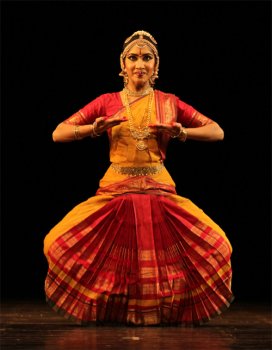 Jyotsna Jagannathan 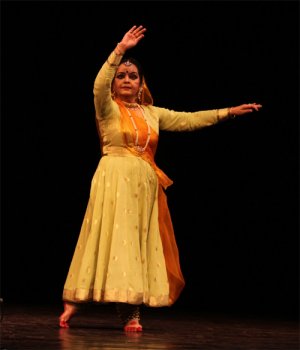 Prerana Shrimali Organized from March 23 till 25 at the Kamani Auditorium, it featured Jyotsna Jagannathan (Bharatanatyam), Prerana Shrimali (Kathak), Naren Chandra Baruah (Sattriya), Swapnasundari (Vilasini Natyam), Sujata Mahapatra (Odissi) and Neena Prasad (Mohiniattam). I could attend Naren Chandra Baruah's Sattriya dances and Swapnasundari's Vilasini Natyam on 24th March. Naren Chandra Barauh from Guwahati has been trained by great masters in Adi Alengi Sattra of Majuli Island from childhood and has already been awarded Bismillah Khan Yuva Puraskar of Sangeet Natak Akademi recently. A brilliant male dancer, Naren has appeared twice within a month in the Capital showcasing the best of Sattriya dances in a sophisticated form with refined nritta, pure dance movements and restrained abhinaya, appropriate to the content of the songs, replete with bhakti, the hallmark of dances from the monasteries, moving from confines of the Sattra to the modern stage in urban setting. Assam had this tradition of dances confined to the Sattras for more than 500 years, but it has come to public domain about 50 years ago only, and the form received recognition as a classical dance form of Assam about a decade ago. Since then there has been no looking back for Sattriya exponents and within a decade it has not only become a part of the dance scene in India but also abroad. Beginning with Krishna Vandana, Naren embellished the prayer with suggestive touches of Krishna's childhood episodes - eating earth, opening mouth and showing Vishwarupa to Yashoda, subjugating serpent Kaliya, killing Kamsa, Chanur and lifting mount Govardhana, in quick succession. Then followed Ramdani, Geetor nach and mela nach, pure dance numbers in quick succession. In abhinaya in Tur Basant raga in Pari tala, Suta tala and other talas, he enacted Krishna's beauty, Krishna grazing cows in Brindavan, bedecked with diamond ornaments, and in the finale, elaborately enacted the dancing on serpent Kaliya's hood, the serpent begging forgiveness of the Lord in the end. He interspersed nritta movements in an interesting manner, covering the stage, incorporating Mati Akharas - ground exercises - metamorphosing them into appealing movements and giving a shape to the presentation bringing it on par with margam numbers seen in say Bharatanatyam pada for abhinaya. The interesting part is the use of pure dance movements, though in a quick tempo, but retaining grace of the form. He has a supple body as a result of rigorous Mati Akhara practices in childhood. The musical accompaniment with musical instruments which included flute, violin, cymbals, harmonium, khol and melodious vocal singing, musicians dressed in aesthetic costumes created visual appeal of dignity and serenity. Sattriya dances are in transition and are developing a concert format. In the hands of young exponents like Naren Chandra Baruah, the form has a bright future. 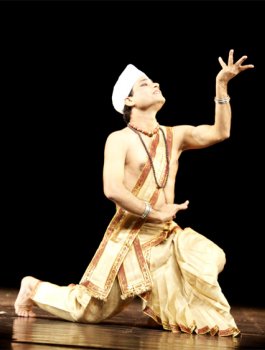 Naren Chandra Baruah 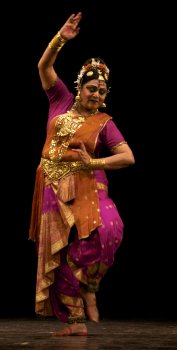 Swapnasundari Swapnasundari's Vilasini Natyam left an indelible impression, in particular in her presentation of Kopeshwar Varnam. The abhinaya as explained by Swapna for each word and its delineation was a sheer delight. The legend has it that Lord Shiva as a Kopeshwar, with a tuft of hair on his head, did appear before the king when he came to see if as the priest had said that the strand of hair he saw in the garland offered to Lord Shiva, was of that of the Lord himself. The priest had fallen in love with the devadasi who offered garland for Lord Shiva; the priest used to first place it on the devadasi and then on the Lord, and a strand of her hair was found when the garland was sent to the king after the ritual. Lord Shiva taking pity on the devotion of the devadasi and the priest saved their lives, appearing before the king with a tuft of hair on his head. Since then, the priest led a pious life. The descendants of the priest are still serving at Kopeshwar Temple in Andhra Pradesh. Swapna studied this rare varnam, a composition nearly 400 years old, from a senior kalavantulu, and added jatis at the right places. Begging the Lord to listen to the request of her friend, the nayika, a devotee of the Lord, appealed to him in various ways. After describing his unparalleled beauty, she resorted to various ways - playing drum, bell, arati and its smoke, requesting Nandi to speak to the Lord, sent serpent playing the musical instrument, offered shower of flowers, but the Lord did not listen. She described his form as Ardhanarishwar, prayed and cajoled, but the Lord did not pay any attention to her various ways of request. In the end she brought her nayika to the Lord, the nayika shedding copious tears, and told the Lord to take care of her. Swapna was in great form. The bhavas were at her beck and call. Her face wore expressions in a trice and with her eloquent eyes, she spoke volumes. Nowadays one rarely sees such abhinaya, the sanchari bhavas, the improvisations. Her mastery over abhinaya had the audience in a thrall. Swapna has carved a niche for herself and the connoisseurs were thrilled to witness such a rich dance number. Her team of musicians lent her excellent support. 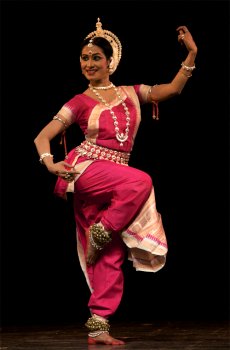 Sujata Mohapatra 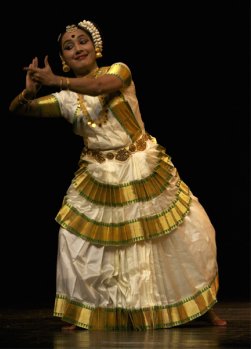 Neena Prasad On the final day, I could attend Sujata Mohapatra's Odissi recital. She is a name to reckon with in Odissi. She has achieved a high reputation as a performer, having been groomed by Guru Kelucharan Mohapatra after initial training under Kum Kum Mohanty. She has imbibed his training thoroughly and when one watches her nritta, the perfection takes one's breath away. Her movements are sculpted, resolutions are perfect, command over tala and laya praiseworthy and restrained abhinaya, full of auchitya, propriety. Beginning with Guru Vandana, choreographed by Kelubabu, she evoked great nostalgia for some of us who have watched Sanjukta and Raghunath Panigrahi in Yugma Dvandva - a number set to music by Raghunath in which Sanjukta and he had marvelous jugalbandi, he rendering the solfa syllables in swaras - and she matching them through nritta- in raga Bageshri. Ah, what a joy it was to see them. Ratikant has done new choreography for this number and also played pakhavaj. Both of them were in great form. To Subas Pani's music, Ratikant also choreographed Raseharimiha ashtapadi for Sujata. This was presented specially for the festival. With excellent nritta and appropriate abhinaya, Sujata did justice to the ashtapadi, which looked refreshingly new. She concluded her performance with Durga stuti, weaving in iconic images of Goddess Durga, wielding various instruments in her different hands, showing both her benign and demonic forms, to imaginative lighting by Jaydev. There was an aura of Shakti, energy in her rendering. Sujata looked completely immersed in this number, which won heartfelt applause from the large appreciative crowd that had filled up the Kamani Hall. Sanhati Pani, daughter of Subas Pani, was master of the ceremony, giving details of the program in a thoroughly professional manner. In every session, the artiste and accompanying musicians were honoured by a scholar, critic, guru or connoisseur and the program started daily dot on time. The organization was flawless and doubtless has won over audiences consisting of true rasikas in the capital. One looks forward to attending the fourth edition of the festival in the capital. Nritya Bharati indeed deserves praise for presenting such a rich fare.  Dr. Sunil Kothari is a dance historian, scholar, author and a renowned dance critic. He is Vice President of World Dance Alliance Asia Pacific India chapter, based in New Delhi. He is honored by the President of India with Padma Shri, Sangeet Natak Akademi award and Senior Critic Award from Dance Critics Association, NYC. He is a regular contributor to www.narthaki.com, the roving critic for monthly magazine Sruti and is a contributing editor of Nartanam for the past 11 years. Post your comments Pl provide your name and email id along with your comment. All appropriate comments posted with name and email id in the blog will also be featured in the site. |